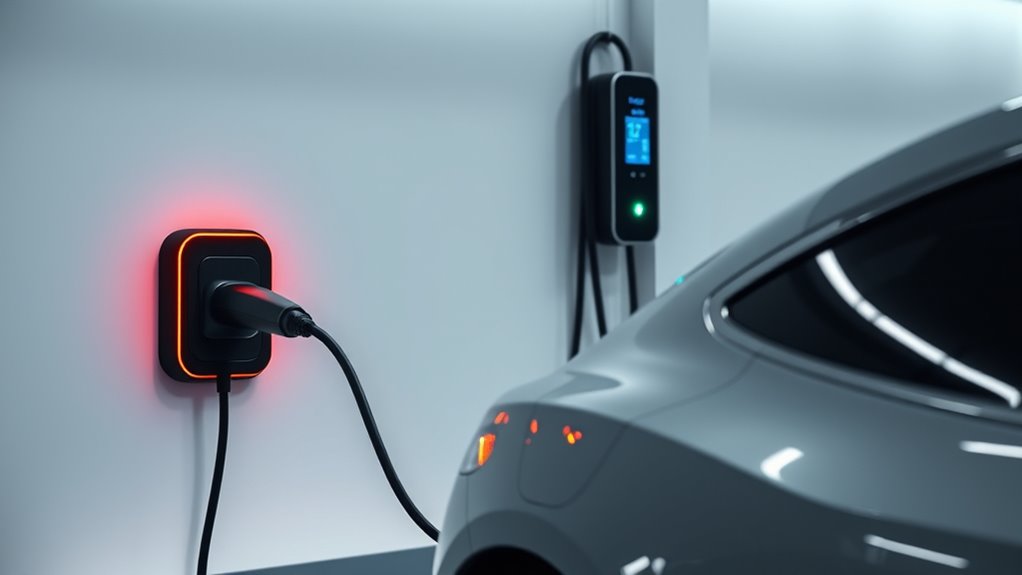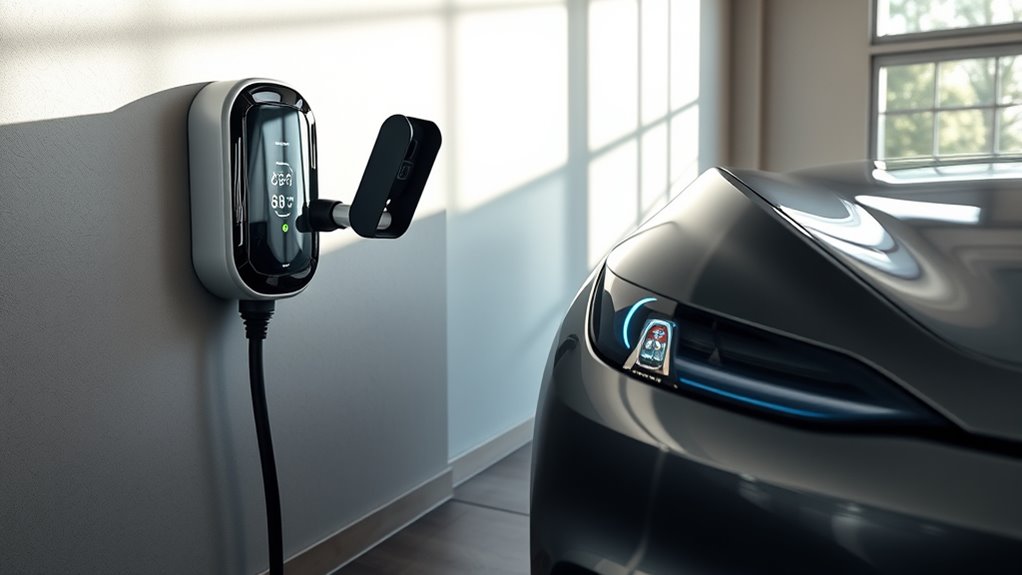When it comes to charging your EV at home, there are three main levels. Level 1 uses a standard 120V outlet, charging slowly but easily with no extra equipment. Level 2 requires a dedicated 240V outlet, offering much faster charging and better suited for daily use. DC fast chargers are typically for public stations, not home use. Exploring the options will help you determine what’s best for your driving habits and home setup.
Key Takeaways
- Level 1 charges via standard 120V outlets, providing slow charging suitable for overnight use.
- Level 2 requires a dedicated 240V outlet, offering faster charging for daily convenience.
- Level 3, or DC fast charging, is mainly for public stations and not typical for home use.
- Home installations for Level 2 may need professional electrical upgrades and specialized equipment.
- Choosing the right level depends on driving habits, vehicle compatibility, and home electrical capacity.

Charging your electric vehicle at home is essential for convenient and efficient daily driving, and understanding the different levels of home charging can help you choose the best option for your lifestyle. The key to a smooth charging experience lies in knowing the various charging station types and ensuring your power outlet matches the required specifications. There are three main levels of home charging, each offering different speeds and installation requirements, so picking the right one depends on your daily driving habits and your home’s electrical setup.
Understanding home charging levels helps you choose the best option for your lifestyle and ensures safe, efficient EV charging.
Level 1 charging is the most basic and involves plugging your EV into a standard household outlet, typically a 120-volt outlet. This method is compatible with most power outlets, making it the easiest to set up without any additional equipment. However, it charges your vehicle slowly—adding about 3 to 5 miles of range per hour. If you only use your EV for short commutes or don’t mind longer charging times overnight, a Level 1 charger could suffice. But keep in mind, not all power outlets are suitable or rated for continuous high-current use, so you should verify your outlet’s capacity and safety to avoid potential issues.
Level 2 charging offers a significant upgrade in speed and convenience. It requires installing a dedicated 240-volt outlet, similar to what’s used for large appliances like dryers or ovens. This type of charging station is compatible with specialized charging units designed for EVs, which you can purchase and install at home. The main advantage is faster charging—adding around 15 to 30 miles of range per hour—so you can fully charge your vehicle in just a few hours. When choosing a Level 2 charger, you need to ensure it’s compatible with your vehicle’s charging port and that your home’s electrical system can support the higher power demands. Consulting an electrician can help verify power outlet compatibility and ensure safe installation. Additionally, selecting a reputable charging station can improve safety and reliability over the long term.
The third level, DC fast charging, isn’t typically used for home installations due to its high power requirements and cost. It’s more common at public charging stations. However, some newer homes with advanced electrical setups might support rapid charging if necessary, but this often involves specialized equipment and permits.
Frequently Asked Questions
Can I Install Multiple Charging Levels in One Home?
Yes, you can install multiple chargers in your home, but you’ll need to take into account installation factors like electrical capacity and wiring. Make sure your electrical system can handle the load of multiple chargers to avoid overloads. Consulting a licensed electrician is essential for proper installation and to ensure safety. Proper planning allows you to set up multiple chargers for different vehicles or charging levels, making your home more versatile and convenient.
How Long Does It Take to Upgrade My Home Electrical System?
Upgrading your home’s electrical system is like giving your house a shot of adrenaline. It typically takes about 2 to 4 hours for a circuit upgrade, depending on complexity, but installing a new electrical panel might take 4 to 8 hours or more. The process involves evaluating your current setup, planning the upgrade, and ensuring safety, so it’s best to work with a licensed electrician to get an accurate timeline.
Are There Government Incentives for Different Charging Levels?
Yes, there are government rebates and incentive programs available for different charging levels. These programs help offset the costs of installing Level 1, Level 2, or fast chargers at your home. You should check with local and federal agencies, as they often offer rebates or tax credits to encourage EV adoption. Taking advantage of these incentives can make upgrading your home charging system more affordable and straightforward.
Is a Special Permit Needed for Higher-Level Chargers?
You generally need a special permit for higher-level chargers, especially if zoning restrictions apply. For instance, imagine installing a Level 2 charger in a residential area; you might need to verify local permit requirements and zoning laws. These regulations ensure safety and proper integration into your community. Always consult your city’s planning department to understand permit requirements and avoid potential issues with higher-level chargers.
How Do I Choose the Right Charging Level for My Vehicle?
To select the right charging level for your vehicle, consider your daily driving needs and charging speed preferences. Think about charging station placement to guarantee easy access and safety considerations, like avoiding wet or cluttered areas. Level 1 chargers are ideal for overnight charging at home, while Level 2 chargers offer faster charging for regular use. Assess your vehicle’s compatibility and your daily schedule to make the best choice.
Conclusion
Understanding EV home charging levels helps you choose the right setup for your lifestyle. Did you know that over 80% of EV owners in the U.S. charge their vehicles at home? By selecting the appropriate charging level, you can save time and money while confidently powering up your car. With the right knowledge, you’ll enjoy the convenience of home charging and contribute to a greener future every day.









